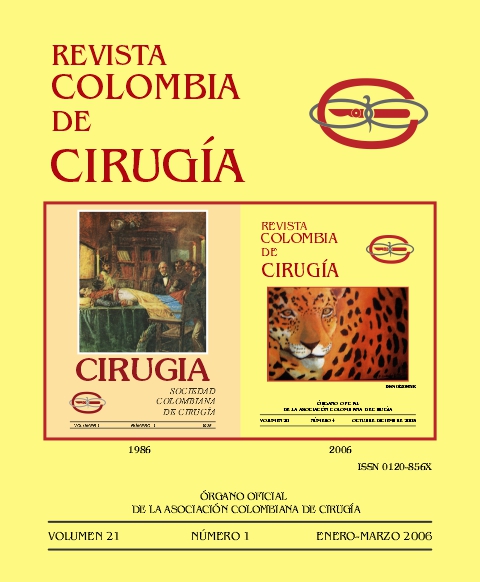Cuadrantectomía con mastopexia tipo "donut" versus cuadrantectomía estándar en cáncer de seno: un estudio comparativo prospectivo
Palabras clave:
cáncer de mama, cirugía conservadora de mama, reconstrucción de mama, cirugía estéticaResumen
Este fue un estudio comparativo prospectivo de 104 pacientes con cáncer de seno, a quienes se ofreció la elección entre dos tratamientos quirúrgicos conservadores: cuadrantectomía con mastopexia tipo donut (Grupo CMD, n=39) o cuadrantectomía estándar (Grupo CE, n=75). Los grupos fueron similares en tamaño radiológico del tumor, localización del tumor en el seno, tamaño histológico, y la distribución por estadios pT. En el grupo CMD, la incisión de piel fue tres veces más grande que en el grupo CE, pero con ella se obtuvo al final, una cicatriz alrededor del complejo areola-pezón, sin complicaciones posoperatorias posteriores. El volumen promedio del espécimen quirúrgico y los márgenes de sección, fueron mayores en el grupo CMD comparados con el grupo CE. Se obtuvieron márgenes libres de tumor con mayor frecuencia en el grupo CMD que en el grupo CE, pero la diferencia no fue significativa. Estos datos indican fuertemente que la técnica CMD puede ser más eficiente que la técnica CE, en términos de precisión en la resección del tejido mamario.
Descargas
Referencias bibliográficas
2. FISCHER B, BAUER M, MARGOLESE R, et al. Five-Year results of a randomized clinical trial Comparing total mastectomy and segmental mastectomy with or without irradiation in the treatment of breast cancer. N Engl J Med 2002; 347: 1233-1241.
3. RADFORD DM, WELLS SA. Surgical techniques in breast conservation. Adv Surg 1993; 26: 1-27.
4. SHROTRIA S. Techniques for improving the cosmetic outcome of breast conservation surgery. Eur J Surg Oncol 2001; 27: 109-112.
5. Anderson BO, Masetti R, Silverstein MJ. Oncoplastic approaches to partial mastectomy: an overview of volumedisplacement techniques. Lancet Oncol 2005; 6: 145-157.
6. MASETTI R, PIRULLI PG, MAGNO S, et al. Oncoplastic techniques in the conservative surgical treatment of breast cancer. Breast cancer 2000; 7: 276-280.
7. AMANTI C, MOSCAROLI A, LO RUSSO M, et al. Periareolar subcutaneous quadrantectomy: a new approach in breast cancer surgery. G Chir 2002; 23: 445-449.
8. HIDALGO DA, BORGEN PJ, PETREK JA, HEERDT AH, CODY HS, DISA JJ. Immediate reconstruction after complete skin-sparing mastectomy with autologus tissue. J Am Coll Surg 1998; 187: 17-21.
9 BRICOUT N. Chirurgie du sein. Paris: Springer-Verlag 1992; 130-142.
10. BENELLI L. A new periareolar mammaplasty: the “round block” technique. Aesthetic Plast Surg 1990; 14: 93-100.
11. RUDGERS EJT. Guidelines to assure quality in breast cancer surgery. Eur J Surg Oncol 2005; 31: 568-576.
12. CLOUGH KB, LEWIS JS, COUTURAUD B, FITOUSSI A, NOS C, FALCOU MC. Oncoplastic techniques allow extensive resections for breastconserving therapy of breast carcinomas. Ann Surg 2003; 237: 26-34.
13. SHESTAK KC, JOHNSON R, GRECO RJ, WILLIAMS, SL. Partial mastectomy and breast reduction as a valuable treatment option for patients with macromastia and carcinoma of the breast. Surg Gynecol Obstet 1993; 177: 54-56.
14. Spear SL, Pelletiere CV, Wolfe AJ, Tsangaris TN, Pennanen MF. Experience with reduction mammaplasty combined with breast conservation therapy in the treatment of breast cancer. Plast Reconstr Surg 2003; 111: 1102-1109.
15. Kaur N, Petit JY, Rietjens M, et al. Comparative study of surgical margins in oncoplastic surgery and quadrantectomy in breast cancer. Ann Surg Oncol 2005; 12: 539 545.
16. SMITT MC, NOWELS KX, ZDEBLICK MJ, et al. The importance of the lumpectomy surgical margin status in long-term results of breast conservation. Cancer 1995; 76: 259-267.
17. Neuschatz AC, DiPetrillo T, Steinhoff M, et al. The value of breast lumpectomy margin assessment as a predictor of residual tumor burden in ductal carcinoma in situ of the breast. Cancer 2002; 94: 1917-1924.
18. Holland R, Hendriks JH, Vebeek AL, Mravunac M, Schuurmans Stekhoven JH. Extent, distribution, and mammographic/ histological correlations of breast ductal carcinoma in situ. Lancet 1990; 335: 519-522.
19. Kerlikowske K, Molinaro A, Cha I, et al. Characteristics associated with recurrence among women with ductal carcinoma in situ treated by lumpectomy. J Natl Cancer Inst 2003; 95: 1692-1702.
Descargas
Publicado
Cómo citar
Número
Sección
Licencia
Todos los textos incluidos en la Revista Colombiana de Cirugía están protegidos por derechos de autor. Las opiniones expresadas en los artículos firmados son las de los autores y no coinciden necesariamente con las de los directores o los editores de la Revista Colombiana de Cirugía. Las sugerencias diagnósticas o terapéuticas como elección de productos, dosificación y métodos de empleo corresponden a la experiencia y al criterio de los autores.


















.jpg)


